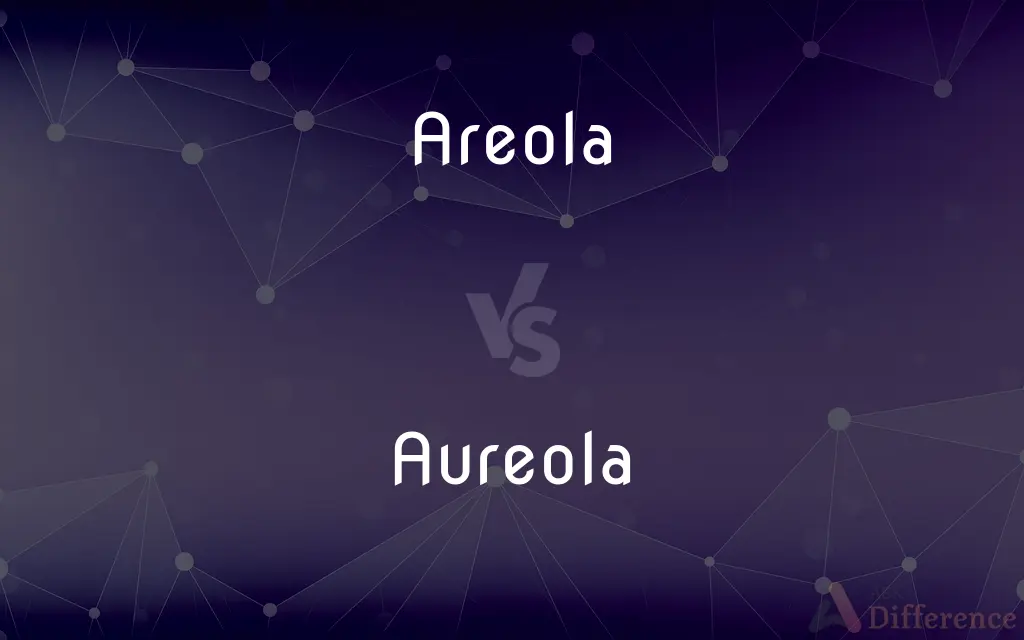Areola vs. Aureola — What's the Difference?
By Urooj Arif & Fiza Rafique — Updated on April 7, 2024
Areola refers to the pigmented area surrounding the nipple, while aureola is a halo or radiance around a sacred figure.

Difference Between Areola and Aureola
Table of Contents
ADVERTISEMENT
Key Differences
Areola and aureola, despite their similar phonetics, denote distinctly different concepts. The areola is a term specifically used in anatomy to describe the pigmented area surrounding the nipple on the breast. It plays a significant role in breastfeeding, where its pigmentation and texture have evolutionary importance. Whereas, aureola refers to a luminous cloud or a halo that is often depicted in art surrounding a holy person or sacred object. This term is largely used in religious and artistic contexts, symbolizing sanctity or divine presence.
The pigmentation of the areola can vary widely among individuals, often deepening in color during pregnancy and breastfeeding. This natural change is thought to aid visual guidance for an infant during feeding. On the other hand, the depiction of an aureola in art varies depending on the culture, era, and artistic style, often seen as a circle of light or a glowing cloud, signifying spiritual or divine light.
In terms of texture, the areola contains small glands known as Montgomery glands, which help lubricate and protect the area during breastfeeding. Whereas the aureola, being a conceptual representation, does not possess physical attributes but is illustrated in various ways to convey a sense of divinity or enlightenment around a figure.
Medical discussions about the areola often focus on health aspects, including conditions like areola changes, infections, and cancer signs. Meanwhile, discussions on aureola are more likely to revolve around art history, symbolism, and religious iconography, reflecting how each term occupies its own niche in human discourse.
While the areola has direct implications for physical health and biological functions, the aureola’s significance is rooted in cultural, spiritual, and artistic expressions. This distinction highlights the diversity of human experience, from the tangible and corporeal to the metaphorical and transcendent.
ADVERTISEMENT
Comparison Chart
Definition
Pigmented area around the nipple
Halo or radiance around a sacred figure
Context
Anatomy, health
Art, religion
Function
Biological role in breastfeeding
Symbolic representation of holiness or divinity
Variability
Color and texture vary among individuals
Depiction varies by cultural and artistic contexts
Associated Terms
Montgomery glands, breastfeeding, pigmentation
Halo, radiance, divinity, sacredness
Compare with Definitions
Areola
Varied in pigmentation.
Her areola darkened during pregnancy.
Aureola
Halo in religious art.
The painting depicted saints with golden aureolas.
Areola
Pigmented area around the nipple.
The doctor examined the areola for any signs of infection.
Aureola
Varied depiction in art.
The artist used light colors to paint the aureola.
Areola
Contains Montgomery glands.
Montgomery glands in the areola secrete protective oils.
Aureola
Symbol of sanctity.
Each apostle was represented with an aureola.
Areola
Important in breastfeeding.
The baby latched onto the areola correctly.
Aureola
Represents divine light.
The aureola around the Buddha signifies enlightenment.
Areola
Subject to medical conditions.
Changes in the areola can indicate health issues.
Aureola
Cultural and era-specific styles.
Medieval aureolas were often circular.
Areola
The human areola (areola mammae, or ) is the pigmented area on the breast around the nipple. Areola, more generally, is a small circular area on the body with a different histology from the surrounding tissue, or other small circular areas such as an inflamed region of skin.
Aureola
An aureola or aureole (diminutive of Latin aurea, "golden") is the radiance of luminous cloud which, in paintings of sacred personages, surrounds the whole figure. In Romance languages, the noun Aureola is usually more related to the disc of light surrounding the head of sacred figures and that in English is called Halo or Nimbus.
Areola
A small circular area, in particular the ring of pigmented skin surrounding a nipple.
Aureola
A circular or oval light surrounding the head or body of a representation of a deity or holy person; a halo.
Areola
A small ring of color around a center portion, as about the nipple of the breast or the part of the iris surrounding the pupil of the eye.
Aureola
(Astronomy) See corona.
Areola
A small space or interstice in a tissue or part, such as the area bounded by small veins in a leaf or the wing of an insect. In both senses also called areole.
Aureola
Radiance of luminous cloud that surrounds the figure in a painting of a sacred personage.
Areola
(anatomy) The colored circle around a nipple, more exactly known as areola mammae.
Aureola
A celestial crown or accidental glory added to the bliss of heaven, as a reward to those (as virgins, martyrs, preachers, etc.) who have overcome the world, the flesh, and the devil.
Areola
Any small circular area that is different from its immediate environment, such as the colored ring around the pupil of the eye (iris) or an inflamed region surrounding a pimple.
Aureola
The circle of rays, or halo of light, with which painters surround the figure and represent the glory of Christ, saints, and others held in special reverence.
Areola
(anatomy) Any of the small spaces throughout areolar connective tissue.
Aureola
A halo, actual or figurative.
The glorious aureole of light seen around the sun during total eclipses.
The aureole of young womanhood.
Areola
An interstice or small space, as between the cracks of the surface in certain crustaceous lichens; or as between the fibers composing organs or vessels that interlace; or as between the nervures of an insect's wing.
Aureola
See Areola, 2.
Areola
The colored ring around the nipple, or around a vesicle or pustule.
Aureola
The outermost region of the sun's atmosphere; visible from earth during a solar eclipse, or in outer space by the use of special instruments; a corona{5}.
Areola
Small space in a tissue or part such as the area between veins on a leaf or an insect's wing
Areola
Small circular area such as that around the human nipple or an inflamed area around a pimple or insect bite
Common Curiosities
Is the aureola always depicted as a circle in art?
While often circular, aureolas can vary in shape and style depending on cultural and artistic contexts.
What does aureola mean?
Aureola refers to a halo or a circle of light depicted around a sacred figure in art.
Do all mammals have an areola?
Most mammals have some form of areola, but its prominence and function vary among species.
What do different colors of aureolas represent?
In art, the color of an aureola can symbolize various attributes, such as purity (white) or royalty (gold).
Is it normal for the areola to have bumps?
Yes, small bumps on the areola are normal and often Montgomery glands, which produce oils for nipple protection.
Can men have an areola?
Yes, both men and women have areolas, although their function is more pronounced in females due to breastfeeding.
What is an areola?
The areola is the pigmented area surrounding the nipple on the breast.
Can the color of the areola change?
Yes, the areola can change in color, especially during pregnancy and breastfeeding.
What does a radiant aureola signify?
A radiant aureola typically signifies divine or supernatural light, indicating a figure’s sacred or enlightened status.
Are there any health conditions associated with the areola?
Yes, conditions such as infections, dermatitis, and signs of breast cancer can affect the areola.
Why is the aureola important in religious art?
The aureola symbolizes holiness, divinity, or spiritual enlightenment, distinguishing sacred figures.
How do artists decide on the style of an aureola?
The style of an aureola is influenced by cultural, religious, and individual artistic interpretations.
What are Montgomery glands?
Montgomery glands are small glands in the areola that secrete oils to moisturize and protect the nipple area.
Does the aureola appear in all religious traditions?
While common in many traditions, the depiction and interpretation of the aureola can vary widely across religions.
Can areola size change?
Yes, the size of the areola can change due to factors like pregnancy, weight changes, and hormonal shifts.
Share Your Discovery

Previous Comparison
Con vs. Cone
Next Comparison
Earthquake vs. VolcanoAuthor Spotlight
Written by
Urooj ArifUrooj is a skilled content writer at Ask Difference, known for her exceptional ability to simplify complex topics into engaging and informative content. With a passion for research and a flair for clear, concise writing, she consistently delivers articles that resonate with our diverse audience.
Co-written by
Fiza RafiqueFiza Rafique is a skilled content writer at AskDifference.com, where she meticulously refines and enhances written pieces. Drawing from her vast editorial expertise, Fiza ensures clarity, accuracy, and precision in every article. Passionate about language, she continually seeks to elevate the quality of content for readers worldwide.














































